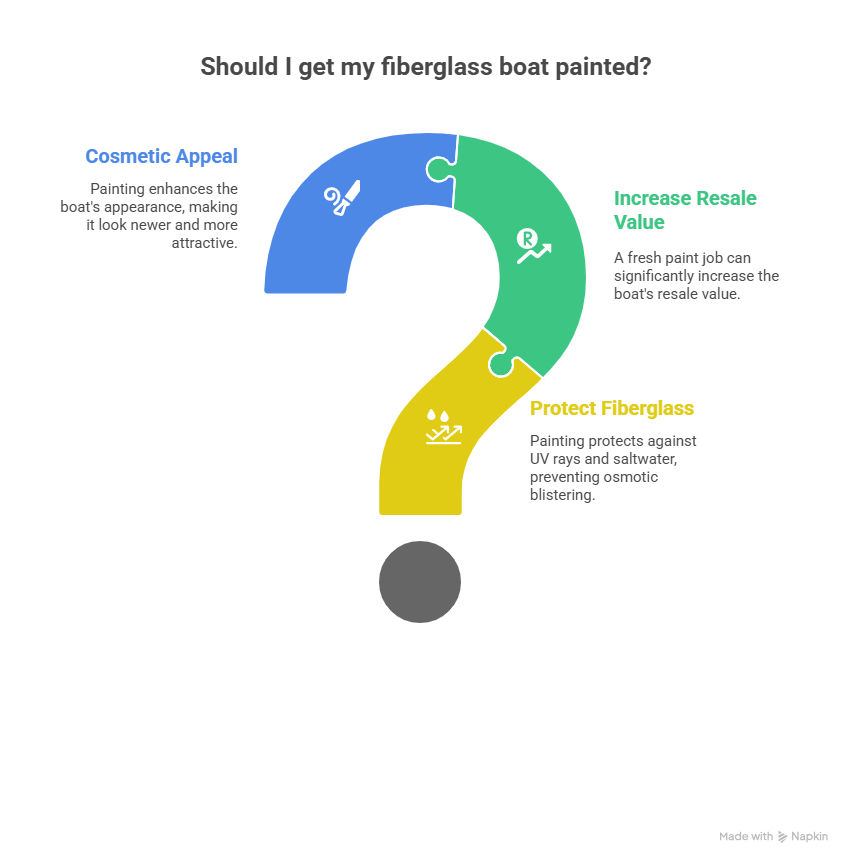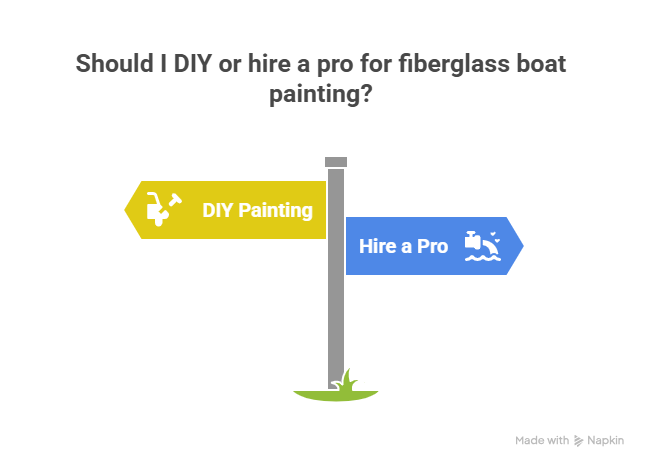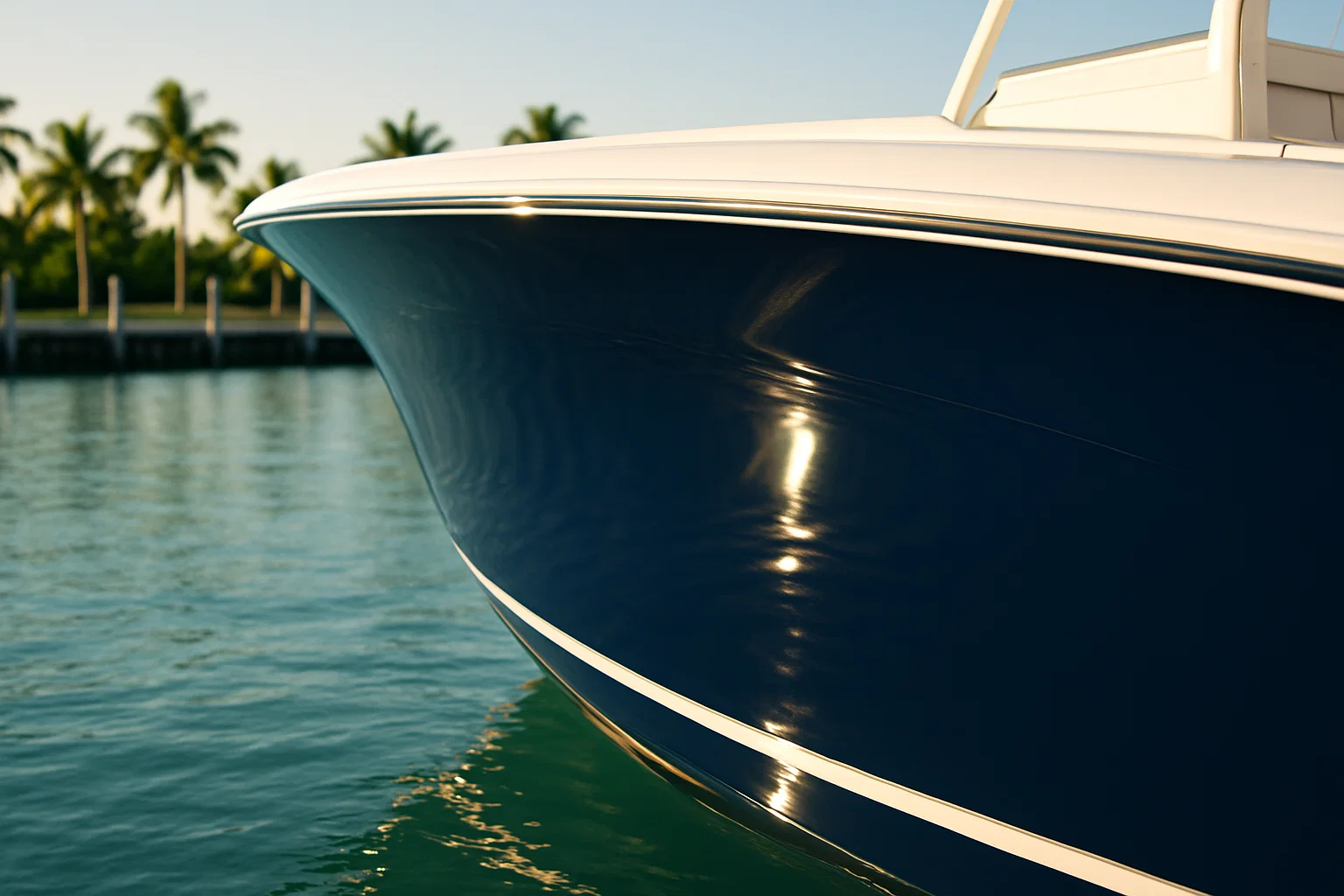I’ve been painting boats in South Florida for 15 years, mostly in Miami and Fort Lauderdale, and let me tell you, a good paint job is like armor for your fiberglass hull. Last June, a guy named Carlos rolled into Dinner Key Marina with his faded 21-foot Sea Ray, desperate for fiberglass boat painting near me. His hull was chalky, scratched, and screaming neglect—$2,500 later, it looked factory-new. That’s what a proper paint job does: it protects your investment, boosts resale value, and makes your boat glide better. Here’s my take on finding fiberglass boat painting near me, from prep to polish, with tips to avoid wasting your money.
Table of Contents
Why Does My Fiberglass Boat Need a New Paint Job?
A fresh paint job isn’t just about looks—it’s a shield against Florida’s brutal sun and saltwater. I’ve seen boats like Carlos’ take a beating from UV rays and moisture, which can ruin fiberglass without proper protection. A quality paint job stops osmotic blistering—those nasty bubbles that cost thousands to fix—and keeps your hull looking sharp.
Last summer, I helped a client, Maria, at Key Biscayne with her Boston Whaler. Her gelcoat was fading, and she was worried about resale. After a $3,000 paint job, her boat’s value jumped 20%. That’s why fiberglass boat painting near me is a smart move—it’s not just cosmetic; it’s maintenance.
What Goes Into a Professional Paint Job?
A pro paint job is a grind—80% of it is prep work. I learned this the hard way in 2010 when I rushed a job and ended up with paint peeling in six months. Here’s the process I follow now, based on hundreds of boats.
How Do Pros Prep a Fiberglass Hull?
Prep is everything. I start by washing the hull with a marine degreaser to kill salt and wax—miss this, and the paint won’t stick. Then, I sand the gelcoat with 80-grit paper to remove oxidation. For scratches or gouges, I use marine-grade epoxy filler, sanding it flush with a 120-grit disc. Last July, I spent 15 hours prepping a client’s Grady-White at Stiltsville—found cracks that would’ve ruined the finish if ignored.
I mask every cleat, vent, and window with 3M tape. Pros remove hardware when possible; amateurs just tape over it, which looks sloppy. A clean, smooth hull is the canvas for a mirror-like finish.
Why Is Primer So Important?
Primer’s the handshake between your hull and the topcoat. I use a two-part epoxy primer like Awlgrip 545—it bonds like glue and stops peeling. After priming, I sand lightly with 220-grit and apply a guide coat to spot imperfections. On a job last month at Bahia Mar, this caught a hairline crack I’d missed—saved the client a $1,000 repair down the line.
How Do Pros Apply the Topcoat?
The topcoat is where the magic happens, but only in a dust-free booth. I spray two-part polyurethane paint like Interlux Perfection for that deep gloss—two to three coats, sanded between with 400-grit. For Carlos’ Sea Ray, I used a spray gun for a flawless finish; roll-and-tip works too but needs skill. A bad topcoat—think runs or orange peel—screams amateur. Fiberglass boat painting near me means finding a shop with a proper booth and steady hands.

How Much Does Fiberglass Boat Painting Near Me Cost?
Costs vary, but here’s what I’ve seen in South Florida. A 17-foot boat might run $400–$2,000 for topside painting, while a 21-footer like Maria’s hits $1,500–$4,000. Bottom painting, with anti-fouling paint, averages $125–$150 per foot. A yacht? Easily $10,000+ if the hull’s rough.
What Drives the Price?
Size is obvious—more hull, more paint, more labor. But condition’s the real kicker. A beat-up hull with crazing or gouges needs hours of fairing, jacking up costs. Materials aren’t cheap either—a gallon of polyurethane paint runs $100–$300. Add yard fees for haul-out ($200–$500) and labor ($80–$150/hour). I always push for itemized quotes; a vague price is a red flag.
Table: Typical Costs for Fiberglass Boat Painting Near Me
I put this table together from jobs I’ve done in Miami:
| Service Type | Description | Average Cost | Availability |
|---|---|---|---|
| Topside Painting | Hull painting above waterline | $400–$4,000 | Most shops, mobile |
| Bottom Painting | Anti-fouling paint below waterline | $125–$150/foot | Specialty shops |
| Full Hull Refinish | Topside and bottom, including repairs | $2,000–$10,000+ | Pro shops with booths |
| Touch-Up Painting | Small repairs or partial repaints | $200–$1,000 | Mobile services |
Should I DIY or Hire a Pro for Fiberglass Boat Painting Near Me?
I get this question a lot at the marina—can I paint my boat myself? It depends on your skills, time, and expectations.
Can I Paint My Boat Myself?
DIY’s tempting—materials for a 17-footer might cost $300–$1,000, saving you labor. But it’s a slog. Sanding, filling, and masking take days, and spraying in your garage risks dust or runs. I tried DIY back in 2009 on my own skiff—ended up with an orange-peel mess that cost $800 to fix professionally. If you’re handy and patient, go for it, but don’t expect a factory finish.
Why Hire a Pro?
Pros deliver what DIY can’t: a flawless, durable finish. They’ve got spray booths, Awlgrip certifications, and years of practice. For Maria’s Boston Whaler, a pro job took three days and boosted her boat’s value by $5,000. Fiberglass boat painting near me means finding someone with the right gear and know-how—saves time and headaches.

How Do I Find the Best Fiberglass Boat Painting Near Me?
Finding a solid painter in South Florida isn’t just Googling “fiberglass boat painting near me.” It’s about digging deeper.
Where Do I Start Looking?
Start at your marina—harbormasters and boaters see the good and bad every day. At Bahia Mar last spring, a dockhand tipped me off about a painter who botched a job—saved me from a $2,000 mistake. Boating forums like TheHullTruth are gold for reviews. Check paint brands like Awlgrip or Interlux for certified shops—they’re trained to do it right.
What Questions Should I Ask?
I grill painters like I’m hiring for my own boat. Ask:
- “Can I see photos of recent jobs and talk to customers?” A pro’s got a portfolio and happy clients.
- “What paint system do you use?” They should name brands like Awlgrip or Interlux and explain why.
- “Can I tour your facility?” A dust-free booth is non-negotiable for fiberglass boat painting near me.
Last month, I vetted a shop in Fort Lauderdale for a client’s yacht. Their booth was spotless, and they showed me a freshly painted Sea Ray—sold me on the spot.
Why Compare Itemized Quotes?
A cheap quote might skip prep or use low-grade paint. I always demand a breakdown: labor hours, materials (e.g., Awlgrip 545 primer), haul-out fees. For Carlos’ Sea Ray, one shop quoted $1,200 with no details—turned out they skipped primer. Another’s $2,500 quote listed every step—worth every penny.
FAQ: Fiberglass Boat Painting Near Me
How Often Should I Repaint My Fiberglass Boat?
Every 5–7 years, depending on exposure. I check my hull yearly for chalking or fading—caught a $1,500 issue early on my Whaler last summer. Use a marine degreaser and inspect under sunlight. Local pros in Miami can assess wear; search “fiberglass boat painting near me” for certified shops.
What’s the Best Paint for a Fiberglass Boat?
Two-part polyurethane like Awlgrip or Interlux Perfection for topsides—durable and glossy. For bottoms, I use anti-fouling paint like Pettit Vivid. I painted a client’s Bayliner with Awlgrip last June; it’s still flawless. Ask pros for brand-specific training.
How Long Does Fiberglass Boat Painting Take?
A 21-footer takes 3–5 days with proper prep. I finished a Sea Ray in four days at Dinner Key, including 15 hours of sanding. Rush jobs sacrifice quality—avoid shops promising same-day finishes. Search “fiberglass boat painting near me” for realistic timelines.
Can I Paint Over Existing Gelcoat?
Yes, with heavy sanding and priming. I sanded a client’s Grady-White to bare fiberglass last July, then applied Awlgrip 545 primer—$2,000 well spent. Skipping prep leads to peeling. Pros know this; find one via “fiberglass boat painting near me.”
How Do I Know If a Painter Is Legit?
Check certifications (Awlgrip, ABYC) and ask for photos or references. I visited a Fort Lauderdale shop last month—saw their booth and a finished yacht. Vague answers or no portfolio? Run. Search “fiberglass boat painting near me” for certified pros.
What’s the Cost of Bottom Painting?
Expect $125–$150 per foot for anti-fouling paint. A 21-footer I did at Stiltsville cost $2,600, including haul-out. Prices vary by hull condition—cracks add hours. Get itemized quotes from shops found via “fiberglass boat painting near me.”
Why Is Prep Work So Important?
Prep’s 80% of the job—cleaning, sanding, and filling ensure paint sticks. I spent 20 hours prepping a yacht in Miami; skipped steps would’ve cost $3,000 in fixes. Pros nail this—search “fiberglass boat painting near me” for quality shops.
Conclusion
A fresh paint job transforms your boat from faded to factory-new, and finding the right pro for fiberglass boat painting near me is the key. It’s not just about looks—it protects your hull, boosts value, and cuts drag. Prep’s the game-changer; 80% of the work happens before paint touches the hull. Get itemized quotes, check certifications, and visit shops to see their booths. A pro job’s worth every penny—my client Maria’s $3,000 paint job added $5,000 to her boat’s value. Start at your marina, ask for references, and search “fiberglass boat painting near me” to find the best.
Author Bio
I’m Alex, a 15-year marine technician in South Florida, specializing in fiberglass boat painting. I’ve painted 200+ boats, from Sea Rays to yachts, with ABYC and Awlgrip certifications. Based in Miami, I’ve seen every hull issue under the sun.


Leave a Reply